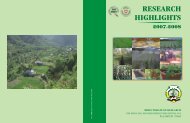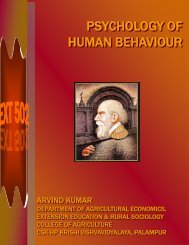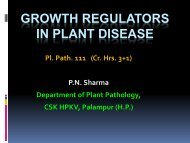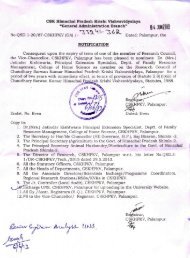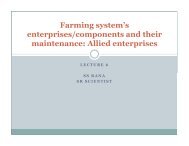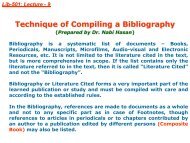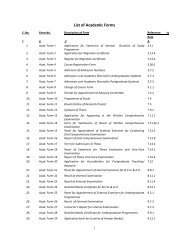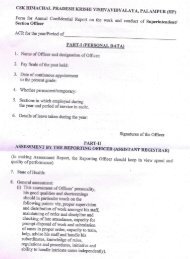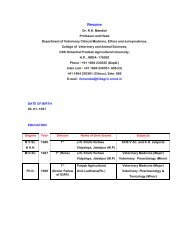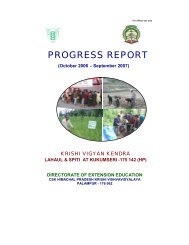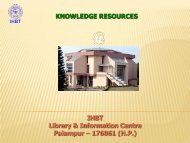animal production - CSK Himachal Pradesh Agricultural University ...
animal production - CSK Himachal Pradesh Agricultural University ...
animal production - CSK Himachal Pradesh Agricultural University ...
Create successful ePaper yourself
Turn your PDF publications into a flip-book with our unique Google optimized e-Paper software.
m. The dried meal of this acquatic plant contains 24.78% crude protein, 15.12% crude fibres, 3.19% calcium, 2.35%<br />
phosphorus, 52.46% neutral digestible fibres(NDF) and a good assortment of micro nutrients. It has been found a good<br />
replacement for cereal byproducts like rice bran, wheat bran in the concentrate feeds of calves and dairy cows. It has also<br />
been found suitable @ 10% in the diets of grower chicks as a replacement of rice bran and groundnut cake.<br />
(v) Dried poultry droppings: This material contains uric acid and some undigested feed proteins and feed dropouts.<br />
This is availabale from the poultry farms where cage rearing management is followed. The droppings contain CP<br />
23.6%, CF 16.50% silica 8.3%, ether-extract 2.5%, calcium 3.86% and phosphorus 1.42% on dry matter basis. The dried<br />
material can be mixed upto 20% in concentrate mixture of dairy <strong>animal</strong>s by replacing wheat bran and mustard cake.<br />
Conservation of fodders<br />
In <strong>Himachal</strong> <strong>Pradesh</strong>, most of the green fodder is available during the monsoon season. This green fodder is<br />
usually in the form of local grasses and cultivated maize, bajra, either alone or in combination with cowpea or soybean.<br />
During the winter season, the green and nutritious forages like berseem or leucerne are usually in short supply and the<br />
<strong>animal</strong>s are maintained either on poor quality hays or straws (by-products of wheat, paddy & maize crops) and some fodder<br />
tree foliages that are also limited in supply. Under such feeding regimens, the dairy cattle <strong>production</strong> is adversely affected<br />
due to the non-availability of balanced fodders. The cultivable area under fodder crops in the <strong>Pradesh</strong> is highly limited<br />
(0.75%) and its diversion to fodder crops is also untenable because the first priority is cereals for food <strong>production</strong> for human<br />
population. Therefore, it becomes essential to augmenting the nutritive value of grasses by the available scientific methods.<br />
There are two scientific ways to conserve the surplus herbage to meet the balanced needs of <strong>animal</strong>s.<br />
Hay making<br />
i. Hay making<br />
ii. Silage making<br />
Hay is any forage crop cut before it is actually dead ripe and suitably dried for storage. It is more nutritious and<br />
palatable than straw, because the entire crop is cut at the proper vegetative stage of growth (strictly before maturity) and<br />
scientifically desiccated. High quality hay is made from fine-stemmed grasses and legumes, harvested at the right stage of<br />
growth and dried in such a way as not to lose any of the nutrients. It is leafy, pliabale, green in colour and free from mould,<br />
weeds, dust and has a pleasant characteristic smell and aroma.<br />
The preservation and storage of surplus herbage has become an important activity for the balanced feeding of <strong>animal</strong>s<br />
and the purpose in making hay is to produce a dried product of high quality. Quality is a cominbation of chemical,<br />
physical and biological properties that influence the intake, digestion and utilization of the forages that further determine the<br />
growth and productivity of the <strong>animal</strong>s consuming them.<br />
To produce a high quality hay, at least two conditions must be observed viz. good forage must be harvested at a<br />
proper stage and it must be dried with minimum loss of nutrients.<br />
Quality of the herbage to be made into hay : The chemical composition and nutritive value of standing herbage at any<br />
one time is influenced by genetic and environmental factors that are highly interrelated. Genetic factors determine the<br />
species of plants, the strain within a species, the type of growth and the response to environmental factors. Some<br />
environmental factors include climate, weather and soil management. Because of the extreme variability of plants and of the<br />
wide range of environmental conditions, even in a limited geographical area, the chemical composition (nutritive value) of<br />
any plant at the time of cutting is unique and perhaps are not exactly alike for all types of plants.<br />
How to feed low grade roughages economically : Good quality hays are better relished by the <strong>animal</strong>s due to their better<br />
palatability, and little residues are left. But the weather conditions in this state are not only highly variable, but the artificial<br />
drying facilities are also highly expensive and thus the quality of hays is not usually good. The grasses normally available<br />
for hay making are also poor in quality and heavily lignified. Lot of straws and stovers, that are the residues of the crops like<br />
wheat, barley, paddy, maize, sorghum and bajra are abundantly available for feeding to the <strong>animal</strong>s during the lean periods<br />
and nutritionally these are very poor. The low-grade roughages i.e. poor quality hays, paddy straw, maize, sorghum and<br />
bajra stalks can be utilized by ruminants more efficiently if they are suitably processed and the protein content is augmented<br />
by adding cheaper non-protein-nitrogenous sources and soluble carbohydrates. The following method is recommended for<br />
improving the palatability, intake and utilization of low-grade roughages by the ruminants:<br />
i. The grass hays, stovers, stalks and straws should be suitably chaffed to the size of 2.0 to 2.5 cm chops.<br />
13



